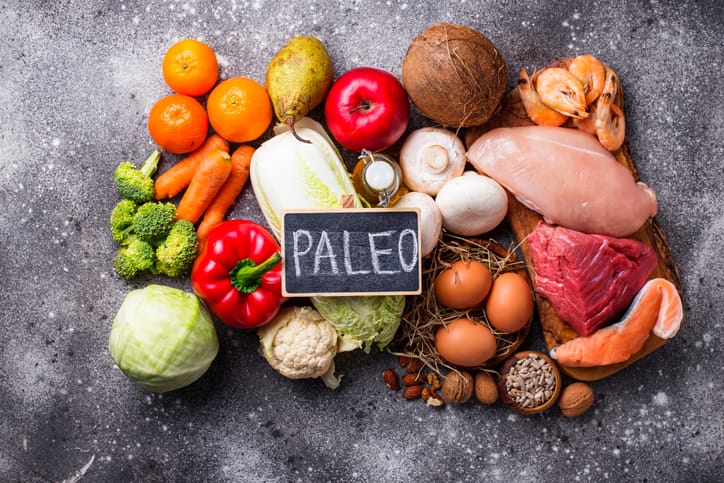The basis of the Paleo diet dates back several million years ago to the Paleolitic era. The diet includes foods that would have been available during the Stone Age as studied by anthropologists. The focus is on whole, minimally processed foods, that could have been hunted and gathered by tribes around the world. The thought is that eliminating the sugars and salts that are often added to today’s processed foods and eating more like our Stone Age ancestors, can prevent many diet related chronic diseases that were nonexistent or far less prevalent during that time.
What is the Paleo Diet?
Like other diet trends, the Paleo diet has rules and guidelines to follow which provide structure as well as restrictions for certain types of foods. There are not necessarily calorie goals or specific macros to track, instead Paleo focuses more on “clean eating” which can make it easier to follow for some people. It could be compared to the ketogenic diet in the sense that it focuses on high protein, low carbohydrates but the Paleo diet does not recommend the significant fat intake that is recommended in a keto diet. Keto and Paleo diets are also similar in that they both have detailed “allowed” and “not allowed” foods. The focus on high protein and restrictions on sugar and carbs makes it appealing to fitness enthusiasts who expect that it will help fuel workouts and produce peak performance.
Join FORM to work with medical weight loss experts who will create a personalized plan for you, combining nutrition, physical activity, mindset shifts, and medication (if appropriate).
See if I qualify
How Does the Paleo Diet Work?
While there are no specific macronutrient requirements as with some other diets , the Paleo diet recommends a roughly equal ratio of protein to carbohydrate to fat, with the lowest allowance going to carbs. There are some discrepancies on certain foods being allowed (or not) depending on who you ask but below are the generally recognized do’s and dont’s of the Paleo diet.
Allowed Foods:
● Vegetables
● Fruits
● Eggs
● Nuts and seeds
● Meat, specifically wild game or grass-fed and antibiotic free beef as to be closer to what our ancestors ate
● Fish, especially those rich in omega 3 fatty acids like salmon, wild caught
● Oils from nuts and seeds
● Some honey
Foods Not Allowed:
● Grains
● Legumes
● Dairy products
● Added sugars
● Added salt
● Processed foods
Paleo Diet and Weight Loss
As previously mentioned, the Paleo diet is recognized for its popularity in relation to improved health and chronic disease reduction. However, it isn’t necessarily an effective weight loss method. While there have been studies that show minimal to moderate weight loss as a result of following the Paleo diet, most studies have small sample sizes and very specific study groups. In one study, there was found to be an 11% mean weight loss at 6 months of following the Paleo diet with little weight regain at 24 months. However, this study had a small sample size (less than 35 participants) of only post menopausal healthy women. Another study found only a 1.8kg loss in 12 months of following the Paleo diet. This study looked at healthy overweight adults (BMI>27kg/m2) and only ended up being about 45 participants. In both
studies participant adherence to the Paleo diet was challenging, and resulted in large drop out rates. In one of the studies a small number of participants elected not to follow the Paleo diet at all when given an option to choose other dietary plans.
Health professionals agree that whole foods, low in salt and added sugars, should be encouraged as part of a healthful diet. The Paleo diet allows lean proteins, fruits and
vegetables, and several sources of unsaturated fats. But the restrictiveness of foods included in the Paleo diet may not be sustainable for most people. Limitations on grains, legumes and dairy can make it very difficult for those who choose to refrain from eating meat to meet protein requirements. Cost can also be a barrier due to the inclusion of high quality meats and unprocessed fruits and vegetables which are typically more expensive than lower quality meat and produce and processed foods. The ability to meet fiber and calcium needs may also be a consideration for those considering the Paleo diet, again due to the exclusion of dairy products, whole grains, and legumes.
Before You Go on Paleo
The Paleo diet can be a helpful approach for weight loss given its focus on high quality unprocessed foods. However, it may be challenging for many people to maintain for the long term. It is important to note that embarking on any diet, including the Paleo diet, is best done with the guidance of a medical professional. As a FORM patient, you work 1:1 with a doctor and Registered Dietitian who support you in your weight loss journey by providing expert advice, personalized nutrition and exercise plans, and, if appropriate, FDA-approved weight loss medication. To learn more about the FORM approach, we invite you to schedule a call. You can also take our quiz to find out if you are eligible for FORM.




